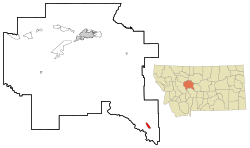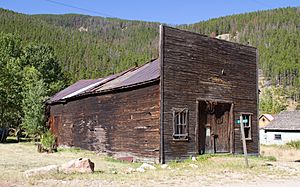Neihart, Montana facts for kids
Quick facts for kids
Neihart, Montana
|
|
|---|---|

Neihart
|
|

Location of Neihart, Montana
|
|
| Country | United States |
| State | Montana |
| County | Cascade |
| Area | |
| • Total | 1.99 sq mi (5.15 km2) |
| • Land | 1.99 sq mi (5.15 km2) |
| • Water | 0.00 sq mi (0.00 km2) |
| Elevation | 5,709 ft (1,740 m) |
| Population
(2020)
|
|
| • Total | 43 |
| • Density | 21.63/sq mi (8.35/km2) |
| Time zone | UTC-7 (Mountain (MST)) |
| • Summer (DST) | UTC-6 (MDT) |
| ZIP code |
59465
|
| Area code(s) | 406 |
| FIPS code | 30-53200 |
| GNIS feature ID | 2413038 |
Neihart is a small town in Cascade County, Montana, United States. It is located right in the middle of the Little Belt Mountains. In 2020, only 43 people lived there. Neihart is part of the larger Great Falls, Montana area.
Contents
Exploring Neihart's Location
Neihart covers about 1.99 square miles (5.15 square kilometers) of land. It sits at an elevation of 5,661 feet (1,725 meters) above sea level.
Roads and Surroundings
The town is located on U.S. Route 89, which is also known as the Kings Hill Scenic Byway. Snow removal teams work hard to keep this road open all winter. Neihart is the only town between Monarch to the north and White Sulphur Springs to the south. The entire town is surrounded by the Lewis and Clark National Forest.
A popular ski area called Showdown, Montana is very close by. It uses the mountainous land for skiing. Just south of Neihart, Route 89 follows Sawmill Creek. The highway then climbs up toward King's Hill, which is a major mountain pass in the Little Belt Mountains.
Discovering Neihart's Geology
The area around Neihart is full of valuable minerals. People have found and mined gold, lead, sapphires, silver, and zinc here. Many of the rocks you see in this area are very old, from the Precambrian era. This was about 542 million years ago or even earlier!
The rocks here are part of something called the Belt Supergroup. They rest against a type of rock called granitic gneiss. You can also often find Amethyst crystals and marine fossils in the area. A unique red-and-green spotted rock called Pinto diorite is also found in large amounts here.
Neihart Quartzite: A Unique Rock
Neihart is one of only three places in the world where you can find Neihart quartzite. This is a reddish, coarse-grained sandstone with layers of dark-green sandstone and shale. This special rock unit was named after the town of Neihart.
Neihart's Climate
Neihart has a semi-arid climate. This means it is usually dry, but not a desert. It is known as "BSk" on climate maps.
| Climate data for Neihart, Montana, 1991–2020 normals, extremes 1967–2008 | |||||||||||||
|---|---|---|---|---|---|---|---|---|---|---|---|---|---|
| Month | Jan | Feb | Mar | Apr | May | Jun | Jul | Aug | Sep | Oct | Nov | Dec | Year |
| Record high °F (°C) | 67 (19) |
64 (18) |
71 (22) |
82 (28) |
86 (30) |
96 (36) |
97 (36) |
97 (36) |
93 (34) |
89 (32) |
73 (23) |
60 (16) |
97 (36) |
| Mean daily maximum °F (°C) | 37.1 (2.8) |
39.6 (4.2) |
46.5 (8.1) |
54.4 (12.4) |
63.2 (17.3) |
71.4 (21.9) |
81.2 (27.3) |
81.3 (27.4) |
72.0 (22.2) |
57.7 (14.3) |
44.0 (6.7) |
36.8 (2.7) |
57.1 (13.9) |
| Daily mean °F (°C) | 26.6 (−3.0) |
27.7 (−2.4) |
34.1 (1.2) |
40.9 (4.9) |
49.0 (9.4) |
56.6 (13.7) |
64.1 (17.8) |
64.1 (17.8) |
55.9 (13.3) |
44.8 (7.1) |
33.8 (1.0) |
26.4 (−3.1) |
43.7 (6.5) |
| Mean daily minimum °F (°C) | 16.2 (−8.8) |
15.9 (−8.9) |
21.7 (−5.7) |
27.3 (−2.6) |
34.8 (1.6) |
41.8 (5.4) |
46.9 (8.3) |
46.9 (8.3) |
39.8 (4.3) |
31.9 (−0.1) |
23.6 (−4.7) |
16.1 (−8.8) |
30.2 (−1.0) |
| Record low °F (°C) | −39 (−39) |
−46 (−43) |
−30 (−34) |
−19 (−28) |
11 (−12) |
19 (−7) |
28 (−2) |
27 (−3) |
4 (−16) |
−13 (−25) |
−26 (−32) |
−44 (−42) |
−46 (−43) |
| Average precipitation inches (mm) | 0.93 (24) |
0.63 (16) |
1.56 (40) |
2.05 (52) |
3.56 (90) |
3.68 (93) |
2.30 (58) |
2.07 (53) |
2.00 (51) |
1.54 (39) |
0.83 (21) |
1.02 (26) |
22.17 (563) |
| Average snowfall inches (cm) | 14.3 (36) |
12.6 (32) |
19.0 (48) |
14.9 (38) |
6.7 (17) |
0.4 (1.0) |
0.0 (0.0) |
trace | 3.2 (8.1) |
9.6 (24) |
10.4 (26) |
13.8 (35) |
104.9 (265.1) |
| Average precipitation days (≥ 0.01 in) | 6.2 | 5.2 | 7.9 | 8.6 | 12.1 | 12.5 | 9.2 | 8.9 | 7.7 | 6.8 | 6.1 | 6.0 | 97.2 |
| Average snowy days (≥ 0.1 in) | 6.0 | 5.3 | 6.9 | 3.7 | 1.3 | 0.1 | 0.0 | 0.0 | 0.7 | 2.9 | 5.0 | 6.1 | 38.0 |
| Source 1: NOAA (precip/precip days, snow/snow days 1981–2010) | |||||||||||||
| Source 2: XMACIS2 | |||||||||||||
The History of Neihart
The story of Neihart began on October 20, 1879. Two prospectors (people who search for minerals), E.A. "Buck" Barker and Patrick Hughes, found silver ore (rock with valuable minerals) in the Little Belt Mountains. Soon, mining towns like Barker and Hughesville appeared.
Founding the Town
In July 1881, three prospectors from Barker—James LeRoy Neihart, John O'Brien, and Richard Harley—found more silver. They started the Queen of the Mountains Mine. When others heard the news, many prospectors rushed to the area. They set up a new mining camp called Canyon City. This camp was later renamed Neihart, after James LeRoy Neihart.
The mining area was never officially organized. But for many years, it was known as the "Montana District." Over the next 75 years, more than 40 mines operated in this region.
Early Growth and Challenges
By 1882, Neihart was big enough to get its own post office. A road was built to White Sulphur Springs. However, the ore was still carried by mule to Barker to be smelted (melted to separate the metal).
When the Barker smelter closed in 1883, a new one was built near Neihart in 1885. By this time, Neihart had a blacksmith's shop, a boarding house, restaurants, two saloons, and stables. About 50 houses were built, but many people still lived in tents. From 1882 to 1929, about $16 million worth of silver was taken from the Neihart area.
Several mines opened, including the Galt, Broadwater, Ball, and Mountain Chief mines. Even with rich ore, it was expensive to get the minerals out. By 1887, many early mines closed because the easiest ore was gone. By 1890, Neihart was almost empty.
Booms and Busts
On November 15, 1891, a train track from the Montana Central Railway reached Neihart. This started a big mining boom! Now, even lower-quality ore could be shipped easily and cheaply to a huge smelter in Great Falls, Montana.
The Panic of 1893 (a time of economic trouble) hurt the mining economy. But Neihart survived because some mines, like the Benton, Big Seven, and Florence, kept working.
Neihart went through many ups and downs over the next 50 years. Mining booms happened during and after World War I, in 1929, and in 1935. The 1935 boom was mostly about mining zinc. Neihart continued to be a major source of zinc during World War II. In 1939, the town had 168 people. After World War II, the train track was removed.
Today, parts of Neihart are abandoned. You can see ghost town ruins on the edges of the town. The remains of an even older camp called Jericho can also still be found in Neihart.
Neihart's Population Over Time
| Historical population | |||
|---|---|---|---|
| Census | Pop. | %± | |
| 1900 | 833 | — | |
| 1910 | 268 | −67.8% | |
| 1920 | 749 | 179.5% | |
| 1930 | 169 | −77.4% | |
| 1940 | 466 | 175.7% | |
| 1950 | 289 | −38.0% | |
| 1960 | 150 | −48.1% | |
| 1970 | 109 | −27.3% | |
| 1980 | 91 | −16.5% | |
| 1990 | 53 | −41.8% | |
| 2000 | 91 | 71.7% | |
| 2010 | 51 | −44.0% | |
| 2020 | 43 | −15.7% | |
| U.S. Decennial Census | |||
Population Details from 2010
According to the census of 2010, there were 51 people living in Neihart. These people lived in 32 households, and 17 of these were families. The town had about 25.6 people per square mile (9.9 people per square kilometer). There were 170 housing units, meaning many homes were empty or used seasonally.
Most of the people (92.2%) were White. A small number (3.9%) were Native American, and 3.9% were from two or more races.
In the 32 households, only 3.1% had children under 18. More than half (53.1%) were married couples. About 43.8% of all households had only one person living there. Many of these (31.3%) were people aged 65 or older living alone. The average household had 1.59 people, and the average family had 2.06 people.
The average age in Neihart was 68.2 years old. Only 2% of residents were under 18. Most residents were older: 31.4% were between 45 and 64, and 56.9% were 65 or older. The town had slightly more males (54.9%) than females (45.1%).
See also
 In Spanish: Neihart (Montana) para niños
In Spanish: Neihart (Montana) para niños


